Owning a dog is a rewarding experience, but it also comes with significant responsibility. What happens when your furry friend bites someone on your property? Could you, as a homeowner, be held liable, even if the person was trespassing? The answer isn’t always straightforward, and understanding your potential exposure is crucial.
Understanding Homeowner Liability for Dog Bites on Your Property
The simple answer is: potentially, yes. However, whether you’re liable for a dog bite hinges on several factors, including state laws, the circumstances of the incident, and whether the injured party was legally allowed to be on your property. Think of it as a sliding scale – the more precautions you’ve taken, and the less right the person had to be there, the less likely you are to be held responsible.
Dog Bite Liability: General Principles for Homeowners
Most states operate under one of two general principles: the “one-bite rule” or strict liability. The “one-bite rule” essentially gives a dog a free pass for its first bite. If you had no reason to believe your dog was aggressive, you might not be liable. However, once a dog has bitten someone, you’re on notice, and subsequent bites could result in significant legal repercussions.
Strict liability states, on the other hand, hold dog owners responsible for bites regardless of prior knowledge of aggression. This simplifies the legal process for the victim, as they don’t need to prove you were negligent. California, Michigan, and Ohio all have elements of strict liability in their dog bite laws.
The Trespasser Exception: When Homeowners Are NOT Liable
Generally, the law is more lenient when the bite victim was trespassing. The assumption is that someone entering your property without permission assumes some inherent risks. However, even with trespassers, liability isn’t automatically off the table.
For example, intentionally using your dog to inflict harm on a trespasser could still lead to criminal and civil charges. Setting a dog on someone actively committing a burglary might be viewed differently than if the dog attacked a child who wandered onto your lawn to retrieve a ball. Many jurisdictions have exceptions for postal workers or meter readers, even if technically on your property without explicit invitation.
Factors Increasing Homeowner Liability in Dog Bite Cases
Several factors can significantly increase your liability risk in a dog bite case:
- “Dangerous Dog” Designations: Many municipalities have ordinances designating certain breeds or individual dogs as “dangerous.” Failing to comply with regulations for these dogs, such as muzzling requirements or specific enclosure standards, dramatically increases your liability.
- Negligence: Even in states without strict liability, negligence plays a major role. Did you fail to properly restrain your dog? Did you ignore warning signs of aggression? Were you aware your dog had a history of biting and did nothing to prevent a recurrence? These are all grounds for a negligence claim.
- Violation of Local Ordinances: Most cities and counties have leash laws, fencing requirements, and other regulations regarding dog ownership. Violating these ordinances can be used as evidence of negligence in a dog bite case.
- “Attractive Nuisance”: This legal doctrine applies when something on your property, like a swimming pool or, potentially, an unrestrained dog, attracts children and creates a foreseeable risk of harm.

Example: In a hypothetical scenario, a homeowner in Texas (a modified “one bite” state) leaves their gate open, and their previously docile dog bites a delivery driver who enters the property. While Texas leans towards a “one bite” rule, the open gate could be seen as negligence, increasing the homeowner’s exposure.
Insurance Coverage and Dog Bite Claims: Protecting Yourself
Your homeowner’s insurance policy typically covers dog bite liability, but coverage isn’t guaranteed. Some insurers exclude certain dog breeds deemed “high-risk” (like pit bulls, Rottweilers, and German Shepherds) or may deny coverage if your dog has a prior bite history.
It’s crucial to review your policy carefully and understand its limitations. If your dog is a breed considered high-risk, or if you’re concerned about potential liability, consider purchasing a separate umbrella policy for extra coverage. Inform your insurance company about your dog – honesty is the best policy, as withholding information could invalidate your coverage.
According to the Insurance Information Institute, dog bite claims accounted for more than one-third of all homeowner’s liability claim dollars paid in 2022, costing nearly $1.13 billion. The average cost per claim nationally was $64,555.
Preventing Dog Bites: A Homeowner’s Responsibility
The best way to avoid a homeowner nightmare is to prevent dog bites in the first place:
- Socialize Your Dog: Early socialization is crucial for ensuring your dog is comfortable around people and other animals.
- Train Your Dog: Obedience training provides structure and helps you control your dog’s behavior.
- Secure Your Property: Ensure your fences are in good repair and gates are securely closed. Post clear “Beware of Dog” signs, especially if your dog has a history of aggression.
- Supervise Your Dog: Never leave your dog unsupervised around children or strangers.
- Be Responsible: Keep your dog on a leash when off your property and comply with all local ordinances.
- Recognize Warning Signs: Learn to recognize signs of aggression or anxiety in your dog and take steps to de-escalate the situation.
What to Do After a Dog Bite Incident on Your Property
If a dog bite incident occurs on your property, take the following steps:
- Ensure Safety: Separate the dog and the injured person. Provide immediate first aid.
- Seek Medical Attention: Encourage the bite victim to seek medical attention, even if the injury seems minor.
- Report the Incident: Report the bite to your local animal control agency. This is often legally required.
- Exchange Information: Exchange contact and insurance information with the bite victim.
- Document Everything: Take photos of the injuries, the scene of the incident, and any relevant damage.
- Contact Your Insurance Company: Notify your insurance company immediately.
- Consult with an Attorney: If the injuries are severe or if you anticipate a lawsuit, consult with an attorney experienced in dog bite litigation.

While no homeowner wants to imagine their dog causing harm, understanding your potential liability is crucial. By taking proactive steps to prevent dog bites and knowing how to respond if an incident occurs, you can protect yourself, your dog, and your community.




